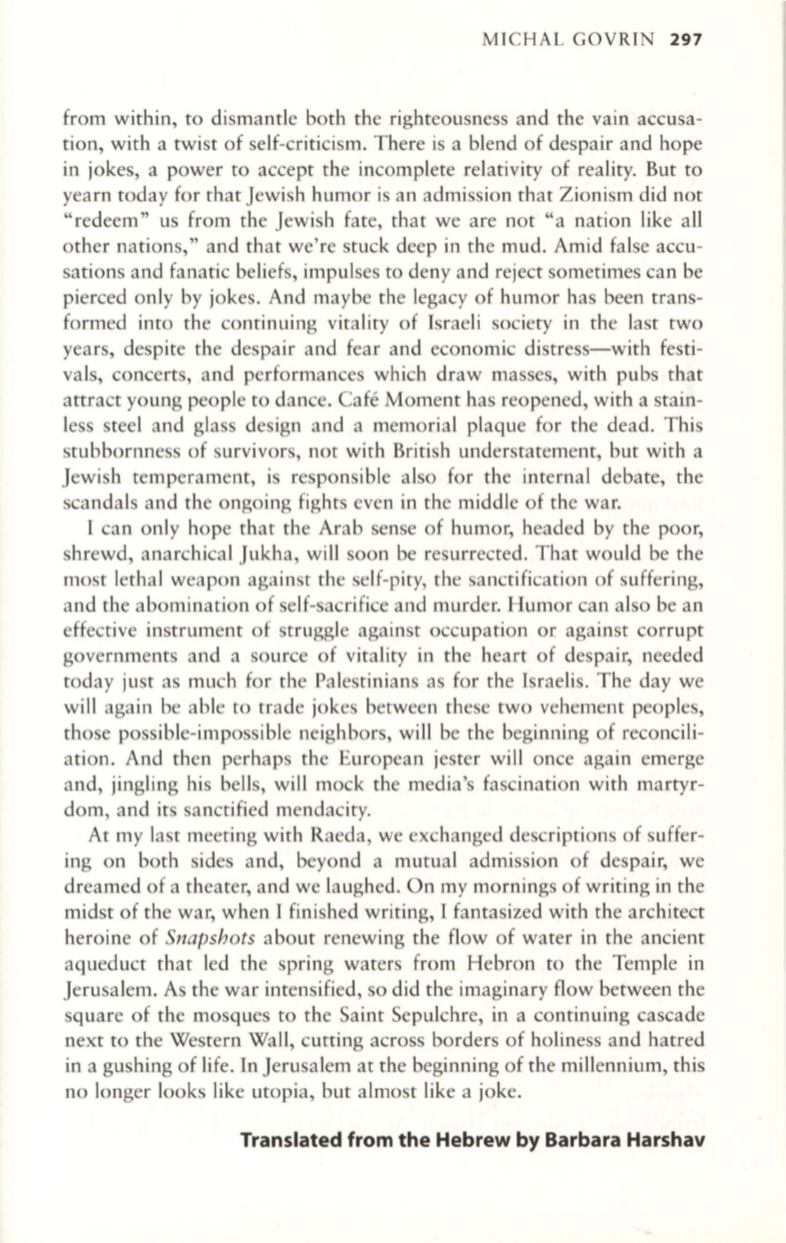
MICHAL GOVRIN
297
from within, to dismantle both the righteousness and the vain accusa–
tion, with a twist of self-criticism. There is a blend of despair and hope
in jokes, a power to accept the incomplete relativity of reality. But to
yearn today for that Jewish humor is an admission that Zionism did not
"redeem" us from the Jewish fate, that we are not "a nation like all
other nations," and that we're stuck deep in the mud. Amid false accu–
sations and fanatic beliefs, impulses to deny and reject sometimes can be
pierced only by jokes. And maybe the legacy of humor has been trans–
formed into the continuing vita lity of Israeli society in the last two
years, despite the despair and fear and economic distress-with festi–
vals, concerts, and performances which draw masses, with pubs that
attract young people to dance. Cafe Moment has reopened, with a stain–
less steel and glass design and a memorial plaque for the dead . This
stubbornness of survivors, not with British understatement, but with a
Jewish temperament, is responsible also for the internal debate, the
scandals and the ongoing fights even in the middle of the war.
I can only hope that the Arab sense of humor, headed by the poor,
shrewd, anarchical Jukha, will soon be resurrected. That would be the
most lethal weapon against the self-pity, the sanctification of suffering,
and the abomination of self-sacrifice and murder. Humor can also be an
effective instrument of struggle against occupation or against corrupt
governments and a source of vita lity in the heart of despair, needed
today just as much for the Palestinians as for the Israelis. The day we
will again be able to trade jokes between these two vehement peoples,
those possible-impossible neighbors, will be the beginning of reconcili–
ation. And then perhaps the European jester will once again emerge
and, jingling his bells, will mock the media's fascination with martyr–
dom, and its sanctified mendacity.
At my last meeting with Raeda, we exchanged descriptions of suffer–
ing on both sides and, beyond a mutual admission of despair, we
dreamed of a theater, and we laughed . On my mornings of writing in the
midst of the war, when I finished writing, I fantasized with the architect
heroine of
Snapshots
about renewing the flow of water in the ancient
aqueduct that led the spring waters from Hebron to the Temple in
Jerusalem. As the war intensified, so did the imaginary flow between the
square of the mosques to the Saint Sepulchre, in a continuing cascade
next to the Western Wall, cutting across borders of holiness and hatred
in a gushing of life. In Jerusalem at the beginning of the millennium, this
no longer looks like utopia, but almost like a joke.
Translated from the Hebrew by Barbara Harshav


